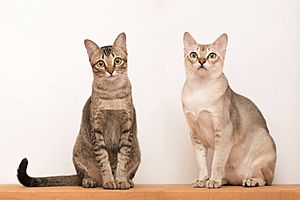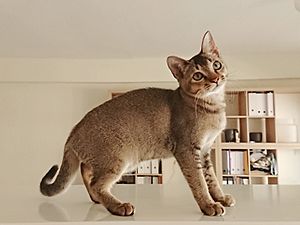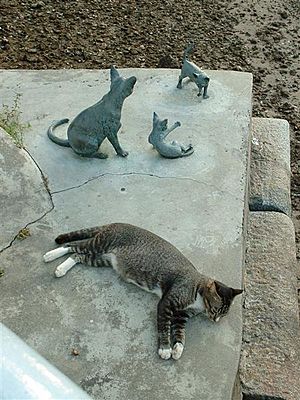Singapura cat facts for kids
Quick facts for kids Singapura |
|
|---|---|

Raw Singapura and Pedigreed Singapura side by side
|
|
| Other names | Drain Cat Kucinta Love Cat |
| Origin | Singapore |
| Breed standards | |
| CFA | standard |
| TICA | standard |
| AACE | standard |
| ACFA/CAA | standard |
| CCA-AFC | standard |
| Domestic cat (Felis catus) | |
The Singapura is one of the smallest cat breeds in the world. These cats are known for their big eyes and ears. They also have a special brown coat with a ticked pattern. Their tails are usually blunt at the end.
The Singapura breed reportedly started from three cats brought from Singapore in the 1970s. These cats were sometimes called "drain cats" because they lived near drains. Later, it was found that these cats had actually come from the US to Singapore first. Even so, the Singapura kept its status as a natural breed.
Contents
History of the Singapura Cat
How the Singapura Breed Started
In 1975, Tommy and Hal Meadow returned to the US after working in Singapore. They brought three local brown-ticked cats with them. These three cats became the foundation for the Singapura breed. Two were kittens from the same litter, and the third was a young female.
The breed's name, Singapura, comes from the Malay name for Singapore. In 1981, another cat that looked like a Singapura was found in Singapore. This cat was also brought to the US to join the breeding program.
Cat organizations like TICA and CFA recognized the Singapura breed. TICA accepted it in 1979, and CFA in 1982. By 1988, it gained championship status. This meant Singapuras could compete in cat shows.
Sometimes, Singapura litters would have a solid-colored kitten. This happened because of a hidden gene called a recessive gene. Breeders worked to remove this gene from their breeding programs. They wanted all Singapura kittens to have the special ticked coat.
Singapuras in Singapore
The Singapore Tourist and Promotion Board (STPB) decided to use the Singapura as a tourism mascot. They called the cat "Kucinta." This name combines two Malay words: kucing (cat) and cinta (love). So, Kucinta means "love cat" or "the one I love."
You can find sculptures of the Singapura cat along the Singapore River.
While some brown cats with ticked coats can be seen in Singapore, most local cats look different. They often have short tails or different coat patterns. The use of the Singapura as a mascot was mainly to attract tourists.
In 2004, the Singapore Zoo had a special exhibit of Singapura cats. This was to celebrate Singapore's National Day. Four Singapura cats were borrowed from their owners for the event.
What Does a Singapura Look Like?
Size and Build
The Singapura is a small but strong and muscular cat. It has a very short and fine coat. Adult females usually weigh about 1.8 kilograms (4 pounds). Males are a bit heavier, weighing around 2.7 kilograms (6 pounds).
Their large, slightly pointed ears are a key feature. They also have big, almond-shaped eyes. The tail is thin and a bit shorter than the body. It ends with a blunt tip.
Coat Markings
The Singapura's coat has a "ticked tabby" pattern. This means each hair has dark and light bands of color. Usually, there are two dark bands and two light bands, with a dark tip.
The underside of the cat, including its chest and chin, is lighter. Cat registries only recognize the Singapura in one color. This color is called "sepia agouti." It means dark brown ticking on a warm, light ivory background.
Singapura Personality
Singapuras are known for being active, curious, and playful cats. They are very affectionate and love to be around people. They often like to climb to high places. This gives them a good view of everything around them.
Health of Singapura Cats
Some health concerns for Singapuras include a condition called uterine inertia. This means a female cat's muscles might be too weak to give birth easily. Sometimes, these cats need a C-section to deliver their kittens.
Another issue is Pyruvate kinase deficiency (PKD). This can lead to a type of anemia. Symptoms might include being tired, having diarrhea, or losing weight. A test can show if a cat has PKD or is a carrier. Cats with PKD can often live a normal life.
Some breeders worry about the lack of genetic diversity in the breed. This is because the original group of cats was small. In 2007, a study found that Singapuras have less genetic diversity than many other breeds. To help with this, some breeders have considered breeding Singapuras with other cat breeds. This would help make the gene pool larger and healthier.
In 2013, the UK's Governing Council of the Cat Fancy started allowing some outcrossing. This means carefully breeding Singapuras with other cats. These chosen cats must meet certain health and appearance rules.





